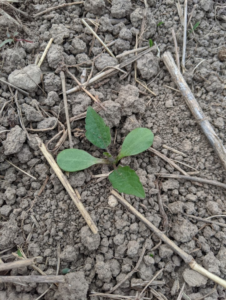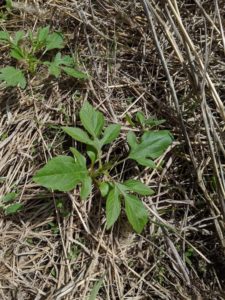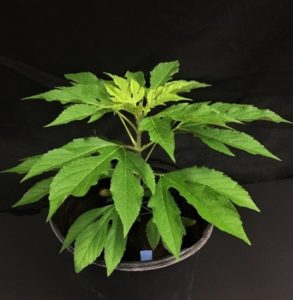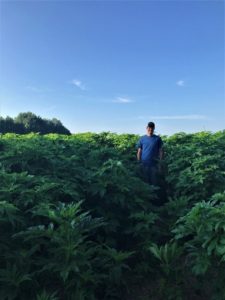Scientific name: Ambrosia trifida
Giant ragweed is a weed member of the sunflower family (Asteraceae) and native to the United States. It is extremely competitive and difficult to control in broadleaf crops. It emerges as early as March and continues to germinate through spring and early summer. Controlling giant ragweed during summer is not only important for crops but also for human health because giant ragweed pollen can be an allergen for some people.
Identification: Seed leaves of giant ragweed are large and oblong. The first pair of true leaves are often unlobed and lance shaped (Figure 1). Subsequent leaves are large and three- or five-lobed with serrated margins (Figures 2 and 3).
Growth habit: Erect summer annual, reaching 3 to 16 ft (Figure 4). Grows at approximately twice the rate of most annual weeds, and is likely to be 8 to 12 inches tall when other weeds are 3 to 6 inches tall.
Reproduction: Giant ragweed reproduces by seed and has separate male and female flowers. Both flower types are green-yellow in color and small. Males flowers appear on slender racemes in the upper terminals and females flowers are clustered in leaf axils. Each plant may produce as many as 10,300 seeds per plant.
Integrated weed management strategies:
Because giant ragweed emerges from very early in spring through summer, a single control measure is often insufficient for season-long control.
- Prevention: For fields with no history of giant ragweed, monitor fields and remove individuals before they set seed.
- Roguing: For small fields with low densities of giant ragweed, consider roguing plants that survive other control measures before they set seed. The seed of giant ragweed is not very persistent. It takes two years to deplete the seedbank by 99%. In large fields and at higher densities, this method will be cost-prohibitive.
- Cultural practices:
- Crop rotation: Rotate to crops that require higher densities and in which you can use herbicides that can control giant ragweed.
- Planting date: Depending on the crop, consider a delayed planting date. By allowing giant ragweed to emerge, it can be controlled at a young stage before planting with tillage or burndown herbicides. If time permits, a second flush could be allowed to emerge and be terminated before planting.
- Chemical control: Selection of proper herbicides and application method is essential because herbicide-resistant giant ragweed populations occur in Indiana. Populations of giant ragweed are resistant to group 2 (ALS inhibitors) and 9 (glyphosate) herbicides, making postemergence control difficult. For more information on chemical control options, consult the Midwest Vegetable Production Guide at https://mwveguide.org/ and the product labels. Here are some general considerations:
- Consider combining pre-plant burndown or cultivation treatments with preemergence and postemergence herbicides.
- Soil-applied, preemergence herbicides will help to suppress weed populations. Consider herbicides in the PPO-inhibitor family such as flumioxazin (ex. Valor®/Chateau®) and fomesafen (ex. Reflex®). These herbicides will require rainfall or irrigation to move them into the soil where weed seeds are germinating.
- Postemergence herbicide use relies on knowing if your giant ragweed population is herbicide-resistant. In general, postemergence herbicide options for broadleaf weeds are limited in vegetable crops. Auxinic herbicides such as 2,4-D (in sweet corn) and photosystem II-inhibitors such as Bentazon (ex. Basagran®) and metribuzin (ex. Sencor®) will provide some measure of control. ALS-inhibitors and glyphosate are options in susceptible populations. For all postemergence herbicide applications, target small weeds less than 4 inches tall.
References
Loux, M. M., Doohan, D., Dobbels, A. F., Johnson, W. G., Young, B. G., Legleiter, T. R., & Hager, A. (2017). Weed control guide for Ohio, Indiana and Illinois.
Steckel, L. (2007). W119 Giant Ragweed. The University of Tennessee Agricultural Extension Service. https://trace.tennessee.edu/utk_agexcrop/66



